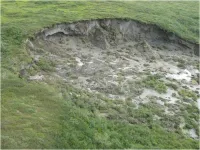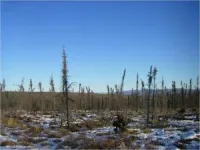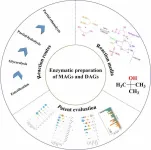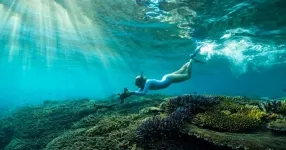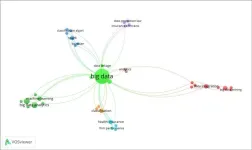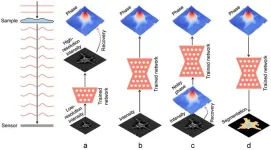(Press-News.org) Alaska is on the front lines of climate change, experiencing some of the fastest rates of warming of any place in the world. And when temperatures rise in the state’s interior—a vast high-latitude region spanning 113 million acres—permafrost there not only thaws, releasing significant amounts of its stored carbon back into the atmosphere where it further accelerates rising temperatures, but it decays. This decomposition has the potential to infuse above- and belowground food webs with carbon, which can affect energy flow between these critical ecological linkages and affect the species they support.
One of these species is the tundra vole, one of four Arctic or boreal forest animals that Philip Manlick, a research wildlife biologist with the USDA Forest Service Pacific Northwest Research Station in Juneau, Alaska, examined as part of his new study published today in the journal Nature Climate Change. Along with collaborators from the University of New Mexico and the University of Texas at Austin, Manlick used a novel technique to quantify the impacts of climate change on energy flow and carbon fluxes between plant-supported aboveground, or green, food webs and microbe-driven belowground, or brown, food webs using two species of vole, a shrew, and a spider as windows into the complex worlds.
“Understanding how energy moves through food webs helps us understand how ecosystems function and how animals might respond to stressors like climate change,” Manlick said. “In Arctic and boreal ecosystems, it’s well known that the climate is warming, permafrost is melting, and microbes are flourishing. But we know very little about the impacts of this process on terrestrial food webs and the animals they support.”
A Novel Technique With Promise
The novel technique at the heart of the study involved measuring unique carbon isotope “fingerprints” in essential amino acids that only plants, bacteria, and fungi can produce. Animals can only acquire these molecules through their diets. This allowed these essential amino acids to serve as a biomarker that helped the researchers track how carbon was moving between green and brown food webs, which, ultimately, helped them detect changes.
“Scientists often argue about the importance of animals to ecosystem processes like carbon cycling, but when they eat resources from different food webs, they move carbon between storage pools,” Manlick said. “In the future, we think this tool can be used to trace the fate of carbon through food webs to understand the functional roles of animals in ecosystem functions, like nutrient cycling.”
The study analyzed bone collagen from museum specimens of tundra and red-backed voles and masked shrews from the Bonanza Creek Experimental Forest near Fairbanks, Alaska, in 1990 and 2021, a sample that represented animals exposed to long-term climate warming. To study the effects of short-term climate warming on animals, the researchers sampled Arctic wolf spiders near Toolik Lake, Alaska. Some of the spiders were gathered as controls and others were exposed to 2 °C warming in outdoor compartmentalized habitats called “mesocosms” in which the scientists could increase temperature on a micro scale to simulate climate warming.
At just over 12,000 acres, and encompassing interior forest and flood-plain habitats, Bonanza Creek Experimental Forest is an ideal site for studying the impacts of climate change on boreal forests and food webs because it provides a long-term record of change in interior Alaska. It was established by the USDA Forest Service 60 years ago and has been a National Science Foundation Long-term Ecological Research site since 1987. For Manlick, the site offers an opportunity to study how these boreal forest changes are affecting the animals living there and how the animals, themselves, affect forest processes through foraging and food web dynamics.
Significant Shift in Energy Source
Through their isotope analyses, Manlick and his colleagues detected significant changes in carbon assimilation in the mammals—notably a shift from plant-based food webs to fungal-based food webs. In other words, fungi replaced plants as the main energy source—with small mammals, like the shrews, assimilating up to 90 percent of their total carbon intake from fungal carbon, a more than 40-percent increase over historical specimens.
The same was true for the Arctic wolf spiders. They, too, shifted from plant-based to fungal-based food webs as the main source of their energy, assimilating more than 50 percent brown carbon under warming conditions, compared to 26 percent at control sites.
“Our study presents clear evidence that climate warming alters carbon flow and food web dynamics among aboveground consumers in Arctic tundra and boreal forest ecosystems—across species, ecosystems, and long- and short-term warming scenarios,” Manlick said. “And we show that these changes are the consequence of a change from predominantly green, plant-based food webs to brown, microbe-based food webs.”
What’s behind the shift?
The scientists suspect brown carbon is being transferred to aboveground consumers, like the mammals and spiders, in a series of predation events known as trophic pathways. Increased warming results in increased decomposition in both permafrost on the tundra and in boreal forests; fungi feed on this decomposing plant matter and are, in turn, consumed by arthropods, mites, and earthworms that transfer the fungal carbon upward in the food web where they, in turn, are consumed by the voles, shrews, and spiders.
“Climate warming significantly alters the flow of energy through food webs, such that animals who were historically supported by plant-based food webs are now supported by fungal-based food webs derived from belowground decomposition,” Manlick said.
Animals Can Alter Carbon Cycling
Manlick and his colleagues’ work underscores that animals serve as a crucial link between green and brown food webs; it also shows that climate warming alters this link across species in the Arctic and in boreal forests. The potential implications of these climate-induced shifts are greater than the small size of these species might imply.
“Shifts in these interactions can have indirect effects on nutrient cycling and ecosystem function,” Manlick said.
For example, if voles are getting more of their energy from belowground sources, they may be consuming fewer plants, which could increase carbon storage in aboveground ecosystems.
“Much of the current work in high latitudes has focused on ‘Arctic greening,’ or the idea that climate warming is leading to more plant growth and greener ecosystems. We found the exact opposite pattern—food webs are ‘browning,’” he said.
Moving forward, Manlick plans to study why these patterns in plants and animals differ and what it means for the future of these rapidly changing ecosystems.
END
Microbial awakening restructures high-latitude food webs as permafrost thaws
New study shows that fungi are replacing plants as primary energy source for Arctic and boreal animals
2024-01-03
ELSE PRESS RELEASES FROM THIS DATE:
Bacteria load their syringes
2024-01-03
Disease-causing bacteria of the genus Salmonella or Yersinia can use tiny injection apparatuses to inject harmful proteins into host cells, much to the discomfort of the infected person. However, it is not only with a view to controlling disease that researchers are investigating the injection mechanism of these so-called type III secretion systems, also known as "injectisomes".
If the structure and function of the injectisome were fully understood, researchers would be able to hijack it to deliver specific drugs into cells, such as cancer cells. In fact, the structure of the injectisome has already been elucidated. ...
Greener and feasible production: Enzymatic methods for mono- and diacylglycerol synthesis in the food industry
2024-01-03
MAGs, predominantly in 1(3)-MAG form, and DAGs, with 1,3-DAGs as the more stable isomer, are crucial in food, cosmetic, and other industries. While MAGs are vital emulsifiers, comprising 75% of global production, DAGs are known as functional cooking oils that can reduce body fat and serum TAGs. However, their natural concentration in oils is low, prompting extensive research into their chemical and environmentally-friendly enzymatic production.
Recently, a review published in the Grain & Oil Science and Technology journal on 2 November 2023, has shed light on the advancements in enzymatic production methods with special efforts on practical and ...
Re-calibrating the sail plan for Native Hawaiians, Pacific Islanders in ocean sciences
2024-01-03
In Hawaiʻi and across much of Oceania, Pacific Islanders celebrate the connections between their islands and the ocean that surrounds them. “As descendants of the ocean, the dearth of Native Hawaiians and Pacific Islanders (NHPI) in ocean science seems inconsonant,” writes a team of authors that includes University of Hawai‘i (UH) at Mānoa faculty, students, and alumni in an article in a special issue of the journal Oceanography, “Building Diversity, Equity, and Inclusion in the Ocean Sciences. The authors ask, “Where are all our island people in the ...
Monetized evaluation of landscape resources of national parks based on the willingness to pay of multiple interest groups
2024-01-03
In China, national parks represent the country’s most unique natural landscapes. Scientific evaluation of landscape resources is significant for preserving the authenticity and integrity of national parks. Taking Qianjiangyuan National Park System Pilot Zone as an example, this research investigated the willingness of internal group (residents and administrative staff) and external group (tourists) to pay for a hypothetical market project based on the pilot zone via Contingent Valuation Method to acquire the monetized value of landscape resources in the national park, and applied Logistic Regression to analyze the influencing factors. The results show ...
How big data transforms the insurance sector
2024-01-03
In 2022, the insurance industry made a whopping USD 6 trillion globally—more than the entire economy of big countries like Japan and Germany. A new study, published in The Journal of Finance and Data Science, looked at how technology, especially big data, is shaking things up in insurance. Big data means using a lot of information to make better decisions.
The study found that by using big data, insurance companies can understand risks better, offer fair prices and keep customers happier.
“What's surprising is how fast insurance companies are jumping on the big data bandwagon,” says first ...
Deep learning for phase recovery
2024-01-03
Light, as an electromagnetic field, has two essential components: amplitude and phase. However, optical detectors, usually relying on photon-to-electron conversion (such as charge-coupled device sensors and the human eye), cannot capture the phase of the light field because of their limited sampling frequency. Fortunately, as the light field propagates, the phase delay also causes changes in the amplitude distribution; therefore, we can record the amplitude of the propagated light field and then calculate the corresponding phase, called phase recovery. Some common phase ...
Chicken whisperers: humans crack the clucking code
2024-01-03
A University of Queensland-led study has found humans can tell if chickens are excited or displeased, just by the sound of their clucks.
Professor Joerg Henning from UQ’s School of Veterinary Science said researchers investigated whether humans could correctly identify the context of calls or clucking sounds made by domestic chickens, the most commonly farmed species in the world.
“In this study, we used recordings of chickens vocalising in all different scenarios from a previous experiment,” ...
Newly discovered genetic mutation protects against Parkinson’s disease and offers hope for new therapies
2024-01-03
A previously unidentified genetic mutation in a small protein provides significant protection against Parkinson’s disease and offers a new direction for exploring potential treatments, according to a new USC Leonard Davis School of Gerontology study.
The variant, located in a mitochondrial microprotein dubbed SHLP2, was found to be highly protective against Parkinson’s disease; individuals with this mutation are half as likely to develop the disease as those who do not carry it. The variant form of the protein is relatively rare and is found primarily in people of European descent.
The findings appear on January 3, 2024, in the journal Molecular Psychiatry.
First ...
First dive survey of Lake Tahoe’s lakebed finds high amounts of plastic and other litter
2024-01-03
Plastic litter is a growing problem around the world, and new research shows that the bottom of Lake Tahoe is no exception. In one of the first studies to utilize scuba divers to collect litter from a lakebed, 673 plastic items were counted from just a small fraction of the lake.
In the study, published in the November issue of the journal Applied Spectroscopy, researchers from DRI and the UC Davis Tahoe Environmental Research Center teamed up with the nonprofit Clean Up the Lake to take a close look at the litter. First, ...
Study on extremely preterm infants provides important healthcare knowledge
2024-01-03
Infants born extremely prematurely need to get enrichment as an addition to breast milk. But does it make any difference whether the enrichment is made from breast milk or cow’s milk when it comes to the risk of severe complications in children? This has been investigated by a large clinical study led from Linköping, Sweden.
Infants born extremely prematurely, between weeks 22 and 27 of pregnancy, are among the most vulnerable patients in healthcare. The risk of serious complications is very high. Almost one in four extremely premature babies die before the age of one.
There is strong research support for giving breast ...
LAST 30 PRESS RELEASES:
Scientists trace microplastics in fertilizer from fields to the beach
The Lancet Obstetrics, Gynecology, & Women’s Health: Taking paracetamol during pregnancy does not increase risk of autism, ADHD or intellectual disabilities, confirms new gold-standard evidence review
Taking paracetamol during pregnancy does not increase risk of autism, ADHD or intellectual disabilities
Harm reduction vending machines in New York State expand access to overdose treatment and drug test strips, UB studies confirm
University of Phoenix releases white paper on Credit for Prior Learning as a catalyst for internal mobility and retention
Canada losing track of salmon health as climate and industrial threats mount
Molecular sieve-confined Pt-FeOx catalysts achieve highly efficient reversible hydrogen cycle of methylcyclohexane-toluene
Investment in farm productivity tools key to reducing greenhouse gas
New review highlights electrochemical pathways to recover uranium from wastewater and seawater
Hidden pollutants in shale gas development raise environmental concerns, new review finds
Discarded cigarette butts transformed into high performance energy storage materials
Researchers highlight role of alternative RNA splicing in schizophrenia
NTU Singapore scientists find new way to disarm antibiotic-resistant bacteria and restore healing in chronic wounds
Research suggests nationwide racial bias in media reporting on gun violence
Revealing the cell’s nanocourier at work
Health impacts of nursing home staffing
Public views about opioid overdose and people with opioid use disorder
Age-related changes in sperm DNA may play a role in autism risk
Ambitious model fails to explain near-death experiences, experts say
Multifaceted effects of inward foreign direct investment on new venture creation
Exploring mutations that spontaneously switch on a key brain cell receptor
Two-step genome editing enables the creation of full-length humanized mouse models
Pusan National University researchers develop light-activated tissue adhesive patch for rapid, watertight neurosurgical sealing
Study finds so-called super agers tend to have at least two key genetic advantages
Brain stimulation device cleared for ADHD in the US is overall safe but ineffective
Scientists discover natural ‘brake’ that could stop harmful inflammation
Tougher solid electrolyte advances long-sought lithium metal batteries
Experts provide policy roadmap to reduce dementia risk
New 3D imaging system could address limitations of MRI, CT and ultrasound
First-in-human drug trial lowers high blood fats
[Press-News.org] Microbial awakening restructures high-latitude food webs as permafrost thawsNew study shows that fungi are replacing plants as primary energy source for Arctic and boreal animals
